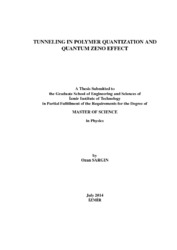Please use this identifier to cite or link to this item:
https://hdl.handle.net/11147/4173Full metadata record
| DC Field | Value | Language |
|---|---|---|
| dc.contributor.advisor | Demir, Durmuş Ali | - |
| dc.contributor.author | Sargın, Ozan | - |
| dc.date.accessioned | 2014-11-17T13:58:33Z | - |
| dc.date.available | 2014-11-17T13:58:33Z | - |
| dc.date.issued | 2014 | - |
| dc.identifier.uri | http://hdl.handle.net/11147/4173 | - |
| dc.description | Thesis (Master)--Izmir Institute of Technology, Physics, Izmir, 2014 | en_US |
| dc.description | Includes bibliographical references (leaves 47-51) | en_US |
| dc.description | Text in English; Abstract: Turkish and English | en_US |
| dc.description | viii, 57 leaves | en_US |
| dc.description.abstract | Polymer quantization is a non-standard and exotic representation of the canonical commutation relations which is introduced in the context of loop quantum gravity to investigate the low energy limit of this non-perturbative quantization of gravity. It is one of the representations of the Weyl-Heisenberg algebra which is inequivalent to the standard Schr¨odinger representation. Since this representation is inequivalent to Schr¨odinger mechanics, by Stone-von Neuman uniqueness theorem there should not be a one to one correspondence between the operators of the two representations. It turns out that, one can not define the position and momentum operators simultaneously in this construction. In this work, we use the standard position operator and a second operator which is the analog of ^p. To define an operator similar to the momentum operator ^p, one needs to use a regularization length scale which can not be removed and stays as a free parameter in the theory. This free parameter is interpreted to descend from the fundamental discreteness of space in loop quantum gravity. As another application of the polymer quantization scheme, in this work we investigate the one dimensional quantum mechanical tunneling phenomenon from the perspective of polymer representation of a non-relativistic point particle, derive the transmission and reflection coefficients and show that they add up to one which is the requirement of probability conservation. Since any tunneling phenomenon inevitably evokes a tunneling time we attempt an analytical calculation of tunneling times by defining an operator well suited in discrete spatial geometry. We expand our time expression in a Maclaurin series around zero polymer length scale and arrive at results which hint at appearance of the Quantum Zeno Effect in polymer framework. Quantum Zeno effect is the inhibition of a quantum system from making a transition from an initial state to a final state. And in summary, as a result of our work we can say that discretization of space leads to the Quantum Zeno effect. | en_US |
| dc.language.iso | en | en_US |
| dc.publisher | Izmir Institute of Technology | en_US |
| dc.rights | info:eu-repo/semantics/openAccess | en_US |
| dc.subject | Quantum Zeno effect | en_US |
| dc.subject | Polymer quantization | en_US |
| dc.subject.lcsh | Tunneling (Physics) | en_US |
| dc.title | Tunneling in polymer quantization and quantum zeno effect | en_US |
| dc.title.alternative | Polimer kuantizasyonunda tünelleme ve kauntum zeno etkisi | en_US |
| dc.type | Master Thesis | en_US |
| dc.authorid | TR160242 | en_US |
| dc.institutionauthor | Sargın, Ozan | - |
| dc.department | Thesis (Master)--İzmir Institute of Technology, Physics | en_US |
| dc.relation.publicationcategory | Tez | en_US |
| item.languageiso639-1 | en | - |
| item.fulltext | With Fulltext | - |
| item.openairecristype | http://purl.org/coar/resource_type/c_18cf | - |
| item.openairetype | Master Thesis | - |
| item.grantfulltext | open | - |
| item.cerifentitytype | Publications | - |
| crisitem.author.dept | 04.05. Department of Pyhsics | - |
| Appears in Collections: | Master Degree / Yüksek Lisans Tezleri | |
Files in This Item:
| File | Description | Size | Format | |
|---|---|---|---|---|
| 10035056.pdf | MasterThesis | 666.92 kB | Adobe PDF |  View/Open |
CORE Recommender
Page view(s)
150
checked on Jul 22, 2024
Download(s)
250
checked on Jul 22, 2024
Google ScholarTM
Check
Items in GCRIS Repository are protected by copyright, with all rights reserved, unless otherwise indicated.